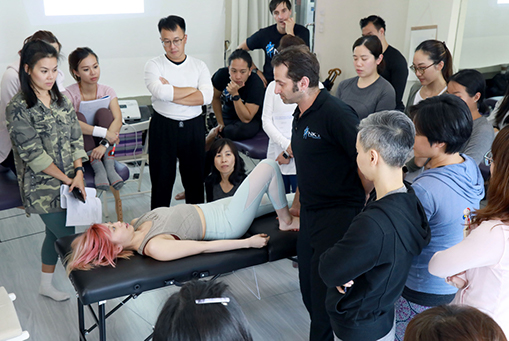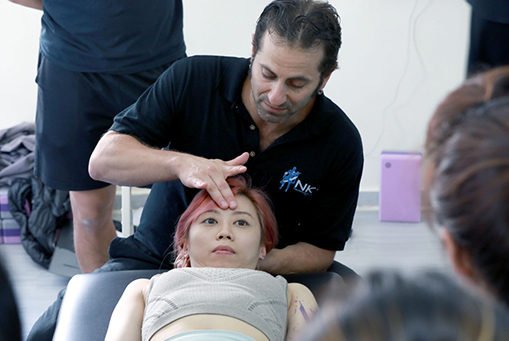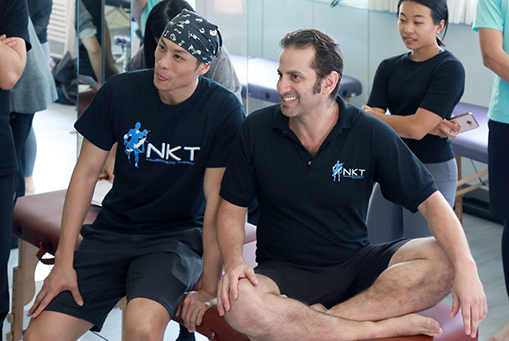NKT Yoga Seminars
Course AgendasNeuroKinetic Therapy® Yoga
The NKT Yoga program combines the NeuroKinetic Therapy® Level 1 protocol with yoga and movement correctives. You will learn manual muscle testing and the basics of motor control theory.
NKT Yoga will show you how to detect if a particular yoga pose or corrective exercise is helping to create strength or accidentally causing dysfunction. You will learn to identify and correct weak areas in the body. This will enhance the effectiveness of your yoga privates and inform all your public classes.
Students will also learn the NKT Yoga Assessment which will become their baseline movement assessment and help guide the direction of all treatments. This assessment provides a foundation for where to look for dysfunction and alleviate pain.
In addition to this, you will learn how to detect for breathing pattern disorders and how to help your students retrain this most vital function. Different strategies will be taught for how to detect the link between breathing patterns and motor control dysfunction.
Day 1: Core and Lower Extremities
9:00 am-10:00 am
Discuss the theory of NKT Yoga; Understand how the MCC coordinates and controls body movements; How to assess muscles imbalances.
10:00 am-11:00 am
Discuss the effect of yoga poses/mobility drills on the joint structures and motor control capabilities. Show the importance of testing and specificity when it comes to giving homework.
11:00 am-1:00 pm
Demonstration of manual muscle testing for the core: Abdominals, psoas, quadratus lumborum, multifidus and gluteus maximus. Instruction on how to use of yoga poses and corrective exercises to retrain the motor control center for the above-mentioned muscle groups.
1:00 pm-2:00 pm
Lunch
2:00 pm-4:00 pm
Discussion, demo and supervised practice of muscle testing for the deep rotators of the hip, adductors and abductors. Application of yoga and corrective exercises based off of NKT findings.
4:00 pm-5:30 pm
Discussion, demo and practice of muscle testing and yoga corrections for the quads, hamstrings and muscles of the knee.






Day 2: Lower Leg, Neck & Shoulder
9:00 am-9:30 am
Q&A, review of previous day’s material.
9:30 am-11:00 am
Discussion and demo for the muscles of the lower leg (gastroc, soleus, tibialis anterior and posterior, peroneals and muscles of the foot).
11:00 am-1:00 pm
Discussion and demo for muscle testing and yoga corrections for the neck (scms, scalenes, deep flexors and extensor group).
12:00 pm-1:00 pm
Lunch
1:00 pm-2:00 pm
Discussion and demo of muscle testing and yoga corrections of the rotator cuff muscles.
2:00 pm-4:00 pm
Discussion and demo of muscle testing and yoga corrections for the pec minor, mid, low and upper trap, serratus anterior, latissimus dorsi, levator scapulae and rhomboids.
4:00 pm-5:00 pm
Discussion and demo of muscle testing and yoga corrections for the pec major, deltoids, biceps, triceps and forearm muscles.
5:00 pm-5:30 pm
Understanding how to detect which yoga poses or motor control corrections are appropriate and beneficial.
Day 3: NKT Yoga Assessment and Breathing Mechanics
9:00 am-10:00 am
Q&A, review of previous day’s material.
10:00 am-1:00 pm
The NKT Yoga Assessment and applied clinical practice.
1:00 pm-2:00 pm
Lunch
2:00 pm-3:00 pm
Lecture and discussion of breathing mechanics, diaphragm function and its effect on the MCC.
3:00 pm-5:00 pm
Demonstration, practice and supervision of NKT testing and Yoga corrections for diaphragm dysfunction.
5:00 pm-5:30 pm
Closing.


ALIGNMENT
Alignment, or Joint Centration, occurs when there is an equal balance of mobilizers and stabilizers around a joint. This puts the joint in its optimal position and allows all the surrounding structures to function properly.
STRENGTH
Yoga is so much more than simply increasing flexibility. The postures challenge us to develop strength and increase our endurance. This enables our tissues to withstand more force and decreases our risk of injury.
MOBILITY
Mobility refers to the ability to consciously and intentionally move a muscle or limb through space. When we mobilize an area that was previously stuck, we generate greater tissue health and ease of movement.
